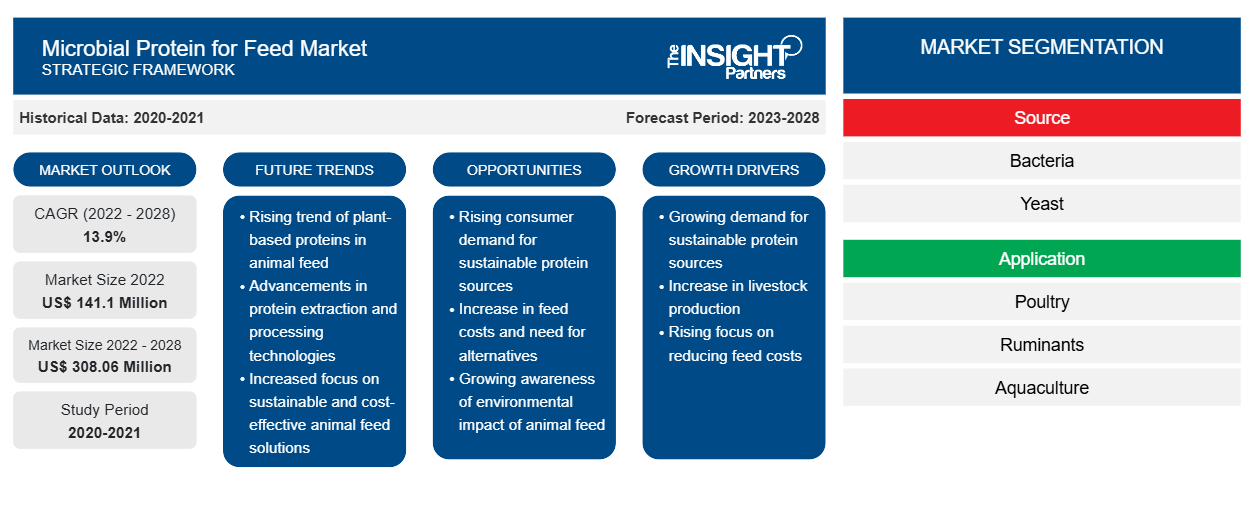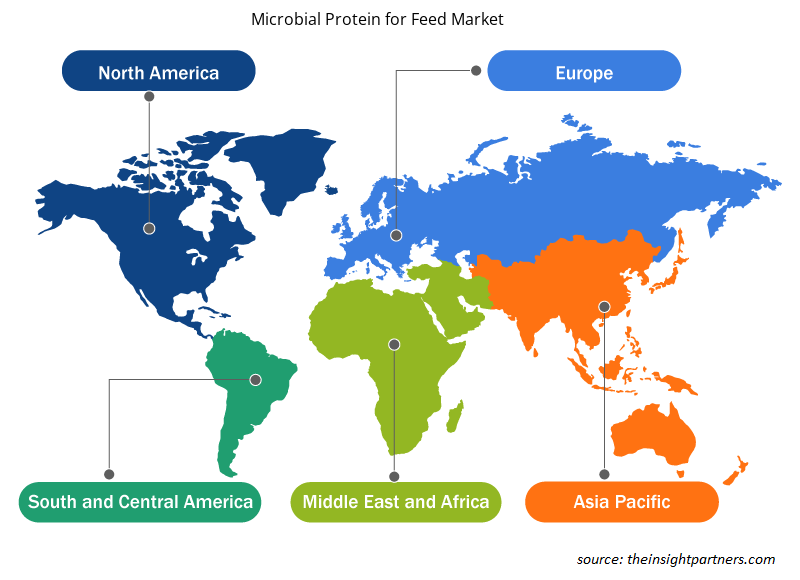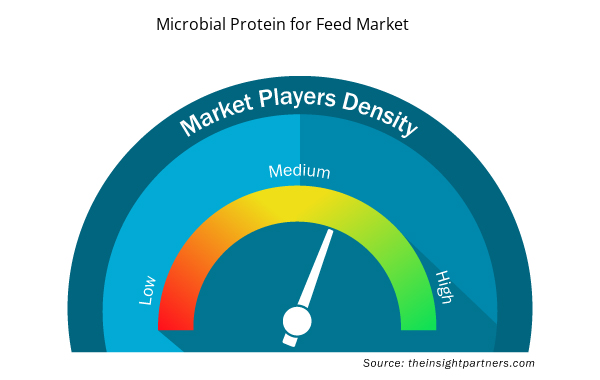The microbial protein for feed market size is expected to grow from US$ 141,095.88 thousand in 2022 to US$ 308,055.17 thousand by 2028; it is estimated to register a CAGR of 13.9% from 2022 to 2028.
Microbial protein is one of the significant sources of crude protein. There are many nutritional benefits of including microbial protein in animal feed. Microbial protein contains more than 70% crude protein, whereas soymeal contains 40–50% crude protein, and fish meal contains 60–65% crude protein. Moreover, it has an ideal amino acid profile, including higher valine, tryptophan, isoleucine, and leucine compared to fish meals. Microbial protein is one of the excellent alternatives to conventional sources of proteins such as soybean and fish meal. It is produced using cost-effective substrates such as industrial gases (carbon dioxide, methane, and natural gas), wastewater, and poultry waste (feathers) fermented in a reactor using bacteria, yeast, fungi, or microalgae. Thus, various nutritional benefits of adding microbial protein to livestock diets and rising sustainability concerns are driving the microbial protein for feed market growth.
In 2021, Europe held the largest share of the global microbial protein for feed market. According to the European Feed Manufacturers’ Federation (FEFAC), pig feed production increased by 2.9% in 2020, despite the continued spread of African Swine Fever (ASF) in the region and its impact on pig farming. Several European countries increased their exports to China, benefiting from Germany’s export ban, which led to a surge in pig feed production in 2020. With the rising levels of animal feed production, manufacturers are looking for sustainable feed additives, as animal-sourced and plant-sourced feed additives are not perceived as environment-friendly nowadays. Imported feed materials, such as soy, threaten natural resources and biodiversity. Thus, the demand for microbial protein is increasing among animal feed manufacturers.
Customize This Report To Suit Your Requirement
You will get customization on any report - free of charge - including parts of this report, or country-level analysis, Excel Data pack, as well as avail great offers and discounts for start-ups & universities
Microbial Protein for Feed Market: Strategic Insights

- Get Top Key Market Trends of this report.This FREE sample will include data analysis, ranging from market trends to estimates and forecasts.
Customize This Report To Suit Your Requirement
You will get customization on any report - free of charge - including parts of this report, or country-level analysis, Excel Data pack, as well as avail great offers and discounts for start-ups & universities
Microbial Protein for Feed Market: Strategic Insights

- Get Top Key Market Trends of this report.This FREE sample will include data analysis, ranging from market trends to estimates and forecasts.
Impact of COVID-19 Pandemic on microbial protein for feed market
The feed industry faced crucial challenges such as a shortage of raw materials and laborers, a surge in raw material prices, and disruptions in distribution networks due to lockdowns, travel bans, trade limitations, manufacturing unit shutdowns, and other government-levied restrictions across the globe. This hampered the manufacturing activities of various companies in the animal feed industry, subsequently resulting in increased prices of feed ingredients. In European Union, about two-thirds of member states pointed out the spike in feed prices in the livestock industry during the pandemic. Moreover, during the peak of the pandemic, China closed livestock and poultry trading and slaughter markets in most of the regions. Such barriers in the livestock industry hampered the demand for feed ingredients which had a negative impact on the demand for microbial protein for feed during the pandemic.
In 2021, various economies resumed operations as their governments announced relaxations in the previously imposed restrictions, which boosted the global marketplace. Further, manufacturers were permitted to operate at full capacities, which helped them overcome the demand and supply gap and other repercussions.
Market Insights
Government and Private Sector Investments to Have Positive Impact on Microbial Protein for Feed Market Growth
Climate change and overexploitation of natural resources such as land and water are the leading sustainability concerns in livestock and animal feed industries. As a result, governments of various countries across the globe are funding companies that manufacture animal feed and ingredients using sustainable practices to reduce their overall carbon footprint and support the circular economy growth. Governments and private sector investors are also supporting companies that make animal feed protein from microorganisms as it is one of the most sustainable sources of protein for animal nutrition. For instance, in February 2022, Arbiom—a French American manufacturer of high-quality proteins for animal feed and food applications by processing agricultural waste and wood residues—received an investment of US$ 13.50 million from the France Relance investment program. After receiving the investment, the company announced the construction of its first commercial production plant in France. Thus, the rising government and private sector investment in the microbial protein for feed market is expected to positively impact the market growth over the forecast period.
Source Insights
Based on source, the global microbial protein for feed market is segmented into bacteria, yeast, and others. The bacteria segment held the largest share of the global microbial protein for feed market in 2021 and is expected to register the highest CAGR from 2022 to 2028. Bacteria exhibit the highest growth rates compared to yeast and other microorganisms. Moreover, the amount of protein produced using bacterial culture is the largest. Furthermore, it has more than 70% crude protein and has a favorable essential amino acid profile. According to various studies, 1,000 kg bacteria produce a larger quality of proteins than soybeans and beef cattle. Thus, bacteria are one of the cost-effective and fastest sources of protein for animal feed. All these factors are driving the market for the segment.
The key players operating in the global microbial protein for feed market include Calysta, Inc.; Avecom; Arbiom; KnipBio; ICC; and Alltech. Market players are focusing on providing high-quality products to fulfill customer demand. They are also focusing on strategies such as investments in research and development activities, partnerships, and expansion.
Microbial Protein Used in Feed Microbial Protein for Feed Market Regional Insights
Microbial Protein for Feed Market Regional Insights
The regional trends and factors influencing the Microbial Protein for Feed Market throughout the forecast period have been thoroughly explained by the analysts at Insight Partners. This section also discusses Microbial Protein for Feed Market segments and geography across North America, Europe, Asia Pacific, Middle East and Africa, and South and Central America.

- Get the Regional Specific Data for Microbial Protein for Feed Market
Microbial Protein for Feed Market Report Scope
| Report Attribute | Details |
|---|---|
| Market size in 2022 | US$ 141.1 Million |
| Market Size by 2028 | US$ 308.06 Million |
| Global CAGR (2022 - 2028) | 13.9% |
| Historical Data | 2020-2021 |
| Forecast period | 2023-2028 |
| Segments Covered |
By Source
|
| Regions and Countries Covered | North America
|
| Market leaders and key company profiles |
Microbial Protein for Feed Market Players Density: Understanding Its Impact on Business Dynamics
The Microbial Protein for Feed Market market is growing rapidly, driven by increasing end-user demand due to factors such as evolving consumer preferences, technological advancements, and greater awareness of the product's benefits. As demand rises, businesses are expanding their offerings, innovating to meet consumer needs, and capitalizing on emerging trends, which further fuels market growth.
Market players density refers to the distribution of firms or companies operating within a particular market or industry. It indicates how many competitors (market players) are present in a given market space relative to its size or total market value.
Major Companies operating in the Microbial Protein for Feed Market are:
- CALYSTA INC.
- Avecom
- Arbiom
- KnipBio
- ICC
Disclaimer: The companies listed above are not ranked in any particular order.

- Get the Microbial Protein for Feed Market top key players overview
Key Development:
In June 2022, Calysta Inc. and Adisseo formed a joint venture (JV), "Calysseo," to start their first industrial-scale production facility in Chongqing, China, to produce 20,000 tonnes of FeedKind, a microbial protein for aquafeed, annually. With the successful production and distribution of FeedKind in China, the JV partners are planning to expand the production capacity to 80,000 tonnes annually in the coming years.
Report Spotlights
- Progressive industry trends in the microbial protein for feed market to help players develop effective long-term strategies
- Business growth strategies adopted by developed and developing countries
- Quantitative analysis of the microbial protein for feed market from 2020 to 2028
- Estimation of global demand for microbial protein for feed
- PEST analysis to illustrate the political, economic, social, and technological factors impacting the global microbial protein for feed market growth.
- Recent developments to understand the competitive market scenario
- Market trends and outlook, as well as factors driving and restraining the growth of the microbial protein for feed market
- Assistance in the decision-making process by highlighting market strategies that underpin commercial interest, leading to the market growth
- Self-tanning products market size at various nodes
- Detailed overview and segmentation of the market, as well as the microbial protein for feed industry dynamics
- Size of the microbial protein for feed market in various regions with promising growth opportunities
- Historical Analysis (2 Years), Base Year, Forecast (7 Years) with CAGR
- PEST and SWOT Analysis
- Market Size Value / Volume - Global, Regional, Country
- Industry and Competitive Landscape
- Excel Dataset



Report Coverage
Revenue forecast, Company Analysis, Industry landscape, Growth factors, and Trends

Segment Covered
Source, and Application

Regional Scope
North America, Europe, Asia Pacific, Middle East & Africa, South & Central America

Country Scope
Australia, Brazil, Canada, China, France, Germany, India, Italy, Japan, Kazakhstan, Mexico, United Kingdom, United States, Uzbekistan
Frequently Asked Questions
Rising demand for sustainable feed protein and nutritional benefits of microbial protein over conventional feed protein sources are some of the key driving factors for the microbial protein for feed market.
Based on application, poultry is the fastest-growing segment in the microbial protein for feed market as the demand for poultry meat is growing rapidly with the majority of people preferring chicken over beef and pork due to its low fat and high protein content.
Based on the source, the bacteria segment accounted for the largest revenue share as the bacteria are among the ideal sources for producing microbial protein or single-cell protein (SCP).
Europe accounted for the largest share of the global microbial protein for feed market. With the rising levels of animal feed production, manufacturers are looking for sustainable feed additives, as animal-sourced and plant-sourced feed additives are not perceived as environment-friendly nowadays. Imported feed materials, such as soy, threaten natural resources and biodiversity. Thus, the demand for microbial protein is increasing among animal feed manufacturers in the region.
The major players operating in the global microbial protein for feed market are CALYSTA INC.; Avecom; Arbiom; KnipBio; ICC; and Alltech among few others.
Manufacturers of microbial protein are taking strategic initiatives such as plant capacity expansion and new product development to expand their operations across different geographies is anticipated to create lucrative opportunities for the microbial protein for feed market during the forecast period.
Trends and growth analysis reports related to Food and Beverages : READ MORE..
The List of Companies - Microbial Protein for Feed Market
- CALYSTA INC.
- Avecom
- Arbiom
- KnipBio
- ICC
- Alltech
- Unibio
- Stringbio
- Deep Branch
- EniferBio

 Get Free Sample For
Get Free Sample For